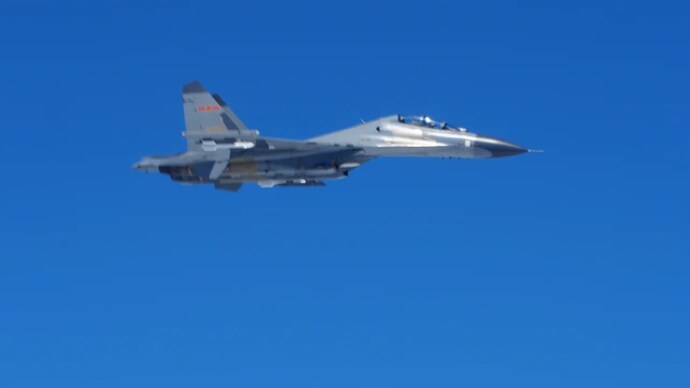
Dumping fuel, artificial turbulence: How US, Russia and China are redefining rules of air warfare
As the frequency of close aerial encounters between the superpowers has dramatically increased in recent times, both the Black Sea and the South China Sea emerge as theatres of contention that could lead to ominous repercussions.

If we mark spots around the globe where the militaries of the world’s superpowers could run into each other, both the South China Sea and the Black Sea would top the chart. Earlier it was rare that the world's most powerful nations would engage in assertive manoeuvring over international waters, but now that is a common sight.
The Pentagon has signalled by releasing a video that a Chinese J-16 fighter performed manoeuvres that forced a US Air Force reconnaissance aircraft to “fly through the wake turbulence of the intercepting aircraft”. US officials alleged that the Chinese fighter flew directly in front of the nose of the US RC-135 Rivet Joint aircraft on May 26 over the South China Sea as it was conducting “safe and routine operations” in international airspace. The proximity of the planes caused turbulence that was captured in the video from the cockpit.
The RC-135V is the aircraft mentioned in the graphic below with its serial number 64-1484 (RC-135V Rivet Joint) that was active over the South China Sea on May 26, based on data provided by open-source flight tracking websites. The Taiwanese Ministry of Defense released a graphic on May 27 showing a single J-16 detected on the same day of the intercept. The relatively smaller flight path lies in the region in which RC-135 transversed.
The encounter comes as the two countries are going through some rocky patches in their relationship following former House Speaker Nancy Pelosi’s trip to Taiwan in August 2022 and the US decision to shoot down a Chinese spy balloon that transited over sensitive U.S. military sites in February this year.
But such instances are no longer rare among world superpowers.
A similar instance of interception between the US and Chinese military aircraft occurred in late December 21, 2022. While conducting regular passage over international airspace, another U.S. RC-135 Rivet Joint was intercepted by PLA’s (Public Liberation Army) J-11 fighter jet over the South China Sea in what the US called an ‘unsafe manoeuvre’. The Chinese fighter came within 20 feet of the nose of the US plane with approximately 30 people inside, forcing the larger and heavier U.S. aircraft to take evasive manoeuvres.
The number of increasingly risky aerial intercepts conducted by Chinese aircraft is alarming as China has been getting more aggressive which could inculcate a mishap or potential unsafe incident.
China claims "indisputable sovereignty” over 90% of the South China Sea, based on a U-shaped nine-dash line, including many islands in the disputed body of water, some of which Beijing has now militarized – building up reefs into artificial islands heavily fortified with missiles, runways and weaponry.
In June 2022, a Royal Australian Air Force P-8A Poseidon maritime patrol aircraft was reportedly damaged by a PLA J-16 over the South China Sea. Australia accused the crew of the Chinese jet of conducting a “dangerous manoeuvre.”
However, both Australia and the United States have rejected nearly all of Beijing’s territorial claims over the sea and routinely conduct exploration operations there, including U.S. freedom of navigation operations(FONOP) through the South China Sea. In 2013, China added a tenth line to take in Taiwan in an attempt to flex its muscles over the region.
Another region of flashpoint for the West is the Black Sea which has been supercharged by the changing dynamics of the Russia-Ukraine war.
The marginal Mediterranean body of water in the Atlantic Ocean lies on Europe’s southeastern flank and has long been a theatre of international contention. With Russia’s invasion of Ukraine, the dynamic between the United States and its European allies camps and Russia and China with its sphere of influence has escalated.
In the first direct confrontation between Russia and the West, the U.S. MQ-9 Reaper drone crashed into the Black Sea after a Russian Su-27 fighter jet released fuel which damaged its propeller.
A video showing two Russian Su-27 fighter jets about 75 miles southwest of Ukraine’s Crimean Peninsula flying close to the US drone, releasing fuel and the propeller being impacted, was released by the Pentagon. The head of the Russian Foreign Intelligence Service said that the US "deliberately and provocatively" flew near its airspace.
American drones have been known to carry out reconnaissance missions in and around Ukraine. The downed MQ9 drone was doing the same in international airspace – which is not under the jurisdiction of any one country – over the Black Sea.
The Chairman of the Joint Chiefs of Staff General Mark Milley said, “There is a pattern of behaviour recently where there are a little bit more aggressive actions being conducted by the Russians.”
More broadly, Russia sees the Black Sea region as vital for access to the Mediterranean and beyond: military operations outside its immediate neighbourhood, protecting its economic and trade links with key European markets, and making southern Europe more dependent on Russian oil and gas.

